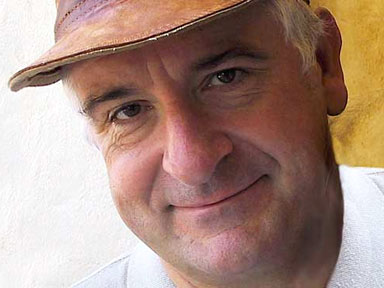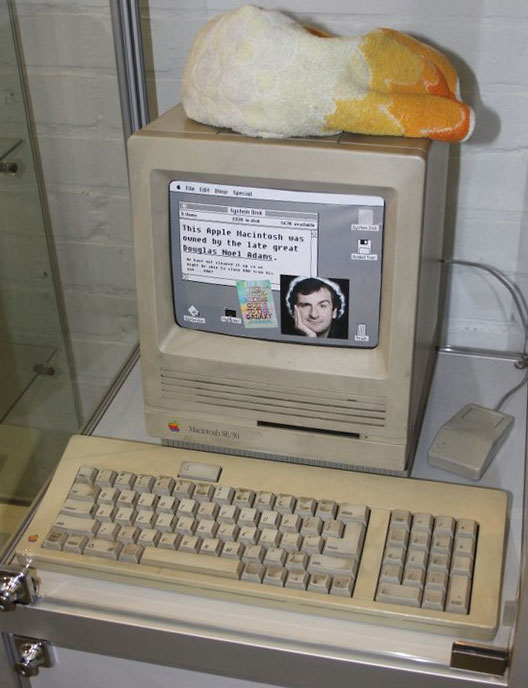Douglas Adams is best known as the author of The Hitch Hiker’s Guide to the Galaxy, which originated as a radio serial on BBC Radio 4 in 1978. In 1979, the first novelized version was published, followed by The Restaurant at the End of the Universe in 1980 and Life, the Universe and Everything in 1982, completing the original trilogy. He was also a Mac user.
The Writer
Adams was born in Cambridge, England on March 11, 1952. In school he was known for his writing and his height – he was six feet tall at the age of 12 and peaked at 6’5″. He was one of only two non-members of the Monty Python team to earn a writing credit, this for the “Patient Abuse” sketch in episode 45, broadcast on December 5, 1974.
 The Hitch Hiker’s Guide to the Galaxy (hereafter HHGTTG) debuted on March 8, 1978 at 10:30 p.m. Despite the late hour and a low-key launch, it generated an enthusiastic audience reaction. The entire 6-episode serial was rebroadcast twice in 1978 and several more time in coming years. It was also re-mastered and issued on an LP, a masterful stroke in part because HHGTTG was the first comedy series produced in stereo – Adams insisted on the same level of production as modern rock albums.
The Hitch Hiker’s Guide to the Galaxy (hereafter HHGTTG) debuted on March 8, 1978 at 10:30 p.m. Despite the late hour and a low-key launch, it generated an enthusiastic audience reaction. The entire 6-episode serial was rebroadcast twice in 1978 and several more time in coming years. It was also re-mastered and issued on an LP, a masterful stroke in part because HHGTTG was the first comedy series produced in stereo – Adams insisted on the same level of production as modern rock albums.
The original 6-episode run has since become known as the Primary Phase. The Secondary Phase, the second 6-episode HHGTTG serial, was broadcast in 1980, bringing the series to a total of 12 episodes. In 1988, the series was released on cassette and CD. HHGTTG was the first BBC Radio series released on CD.
HHGTTG came to television in 1981 on BBC Two, based on the original radio series, the retelling on LP, and the 1979-1980 stage show. Although BBC executives believed it would be impossible to film the story, it was done very successfully. It was voted the Most Original Television Programme of 1981 by the Royal Television Society. (On a personal note, I have seen the series on VHS, and while the story was good, video quality was note. I hope the DVD version looks better. Since there was also a LaserDisc release, and those tend to be of utmost quality, I assume so.]
In 1984, the series was adapted as an interactive fiction game by Infocom, best known for its Zork text adventure series, itself based on the original text adventure computer game, Colossal Cave Adventure (1976). The game was released to almost every personal computer platform.
The first two novelizations covered the original 12 episode. Life, the Universe and Everything was published as a book in 1982 and adapted for radio in 2004, reversing that sequence of events. Also known as the Tertiary Phase, it completed the Hitch Hiker’s Trilogy. It was followed by So Long, and Thanks for All the Fish in 1984, and the Quadary Phase came to radio in 2005. To the consternation of fans, the trilogy now had four books.
Adams took things to the next level eight years later, publishing Mostly Harmless in 1992. Mostly Harmless came to radio as the Qintessential Phase in 2005. This was the last novel in the series written by Adams, who died on May 11, 2001.
Adams had also written the Dirk Gently series of novel about a “holistic detective” and worked on Doctor Who.
HHGTTG was released as a movie in 2005, and Adams co-wrote the screenplay.
And Another Thing… was commissioned by Jane Belson, Adams’ widow, to bring the five volume trilogy to a close. It was developed by Eoin Colfer working from Adam’s notes and other writings. And Another Thing… was published in 2009 and is the only novel in the now-six-book Hitch Hiker’s trilogy with a title that was not taken from a phrase in the original series.
Towel Day is celebrated on May 25 in honor of Douglas Adams and HHGTTG. The first towel day took place on May 25, 2001, two weeks after his death. All that is required to celebrate Towel Day is openly carrying a towel, something we learned about in the Primary Phase.
The Mac User
Adams bought his first word processor in 1982, during the rise of the IBM PC and its compatibles, the beginning of the end for 8-bit home computers and dedicated word processors, and a year before Apple’s Lisa brought the mouse and graphical user interface to the masses.
Adams’ Early Computers
Adams moved to a DEC Rainbow 100 in 1983, a computer that tried to provide both the Z-80-based CP/M operating system and 8088-based MS-DOS to its users. To further increase its flexibility, it could also be used as a VT100 dumb terminal.
Perhaps the biggest barrier to its success was the use of a proprietary 400 KB floppy disk format that made its quad-density disks unusable on industry standard hardware. On top of that, formatted disks could only be purchased from DEC and the versions of CP/M and MS-DOS initially available did not support the format command. Although this was rectivied in later versions, it gave the Rainbow a bad reputation in a very competitive market.
The final nail in its coffin was that although it ran MS-DOS, it was not compatible with software written for the IBM PC, a factor that doomed most competitors to the IBM PC, such as the TI Professional Computer and Tandy 2000.
 Adams later bought an Apricot, followed by a BBC Micro, and later a Tandy 1000, which was mostly IBM compatible. In the field, he used a Cambridge Z88 (right), an early portable computer with a built-in word processor and an 8-line display on its screen.
Adams later bought an Apricot, followed by a BBC Micro, and later a Tandy 1000, which was mostly IBM compatible. In the field, he used a Cambridge Z88 (right), an early portable computer with a built-in word processor and an 8-line display on its screen.
Adams and the Mac
Adams became a Mac user in 1984, the year the Macintosh was released. In fact, Adams was the first person to buy a Macintosh in Europe. There seems to be no exhaustive list of the many Macs he has owned, but I have created a list from a wide range of sources. In some cases, such as his Power Mac G3 and G4 machines, at present we have no indication which model(s) they were.

Adams’ Mac SE/30 on display at the Centre for Computing History – along with the requisite towel.
Macs Douglas Adams Has Owned
- Mac 128K
- Mac Plus (at least 2)
- Mac SE
- Mac II
- Mac IIcx
- Mac SE/30
- Mac IIci
- Mac IIfx
- Quadra 950
- PowerBook Duo
- PowerBook 5300
- Power Mac G3 (at least 2)
- iMac (at least2)
- PowerBook G3
- Power Mac G4
- Power Mac G4 Cube
Further Reading
- Mankind as Sickly as a Parrot: Douglas Adams Leaves His Apple Macs to Tell Steve Homer How Technology Can Rescue a Human Race That Is Stranded Like a Flightless Bird, Independent, 1992.10.02.
- Interview: Douglas Adams, Macreator, March 1999
- Interview with Douglas Adams, Mac3D, 1999.05.02
- Douglas Adams’ Mac IIfx, Wired, March 2003
- Douglas Adams’ last post on his online forum was about excitement over Mac OS X, Engadget
- So Long, Douglas Adams, Dan Knight, Low End Mac, 2001.05.14
- Interview with Douglas Adams, BBC Radio 4, undated
Other Resources
- PowerBook Duo Promo Video Featuring Douglas Adams, YouTube
- Hitchhiker: A Biography of Douglas Adams, M J Simpson, 2005
By Douglas Adams
- Frank the Vandal, 1989
- Under-the-desktop Publishing, 1989-ish for Mac User
- The Little Computer That Could, 1991-ish. Adams mentions Grand Rapids, Michigan, where Low End Mac headquarters is located.
- Douglas Adams’ Guide to the Macintosh, 1992-ish
- Dongly Things, undated, Macworld
- Douglas Adams on Microsoft, 1995
Keywords: #douglasadams #hitchhikersguide
Short link: http://goo.gl/R6mJPV

